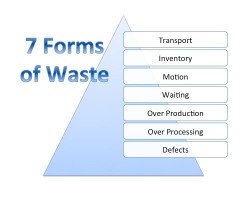In our last post, we took a look at some important Lean basics around understanding value-added versus non-value added activities. We also learned to understand who our customer is, both inside the company and outside. We also started to learn about creating value, what adds value and what does not. Today, we build on this knowledge by learning how to apply these concepts using a Lean framework called the Seven Forms of Waste to thematically evaluate our businesses for non-value added activities.
What are the Seven Forms of Waste?
The Seven Forms of Waste is a framework used in the Toyota Production System, TPS, now commonly referred to as Lean. Using this framework, you can begin to review your company’s project delivery process to identify and eliminate waste or unnecessary non-value-added activities.
Seven Forms of Waste and common residential solar examples
 Below we will review each of the Seven Forms of Waste, what they mean, and provide an example of each so you can learn to see them in your own company.
Below we will review each of the Seven Forms of Waste, what they mean, and provide an example of each so you can learn to see them in your own company.
Transport refers to the unnecessary motion or movement of materials or information, including work-in-process, from one operation to another. This form of waste adds time to the process during which no one adds value. An example of this would be ordering from a vendor that cannot drop-ship directly to the customer site or to your warehouse. Since product must move through several channels, this adds time and the potential for loss or damage in the process that could further delay the project.
Inventory refers to items not directly required to fulfill current customer orders. Inventory includes raw materials, work-in-process and finished goods. Inventory requires additional handling and space, and is often closely associated with waiting and overproduction. An example would be if one were to order more rails, mid-clamps and wire than necessary for the amount of current projects and the run rate of equipment. This mode of thinking can have a compounding effect and could cause company capital to become tied up and unavailable for other uses. It also leads to crowded warehousing space, which could result in other instances of waste or to the leasing of even more warehouse space.
Motion includes built-in extra steps taken by employees to accommodate inefficient process, rework, reprocessing, overproduction or excess inventory. For example, this form of waste can be most obviously seen in extra trips from the job site to the electrical supply house or office for necessary tools or parts that were not provided to the crew.
Waiting is any downstream inactivity that occurs because previous activities are not delivered on time. Idle downstream resources are then often used in activities that either don’t add value or result in overproduction. An example of this would be when installers cannot perform installations because plan sets are not completed fast enough to pull permits and schedule jobs. These installers are then sent out on site evaluations or given warehouse “housekeeping” tasks.
Overproduction occurs when an operation continues after it should have stopped. If a plan set is “overproduced,” it might include additional sheets, viewports and data points above and beyond what the authority having jurisdiction, AHJ, or utility needs to approve the permit or the installer needs to build the project.
Overprocessing occurs any time employees put more work into a project than is required to satisfy the customer. This form of waste also includes using components that are more precise, higher quality or more expensive than initially proposed. For example, a designer spends extra time on a project researching and specifying a nonstandard piece of equipment deemed necessary because of site conditions, despite the fact that the customer did not pay extra money for that equipment.
Defects refer to products or services not conforming to the company’s internal specification or the expectation of an internal spec or final customer, thus leading to customer dissatisfaction. An example of this would be when an installation fails to pass Energy Trust solar design review or onsite verification because it does not meet Energy Trust requirements. This forces project managers and installers to perform rework instead of moving on to another installation, essentially adding unplanned labor hours to the job.
What Next?
With an understanding of the Seven Forms of Waste, you can begin to identify these types of non-value-added activities in your operation and consider them for elimination. In our next post, we will build on this understanding and cover the next step in process improvement: understanding the link between employees, process improvement and ultimately creating customer value.

